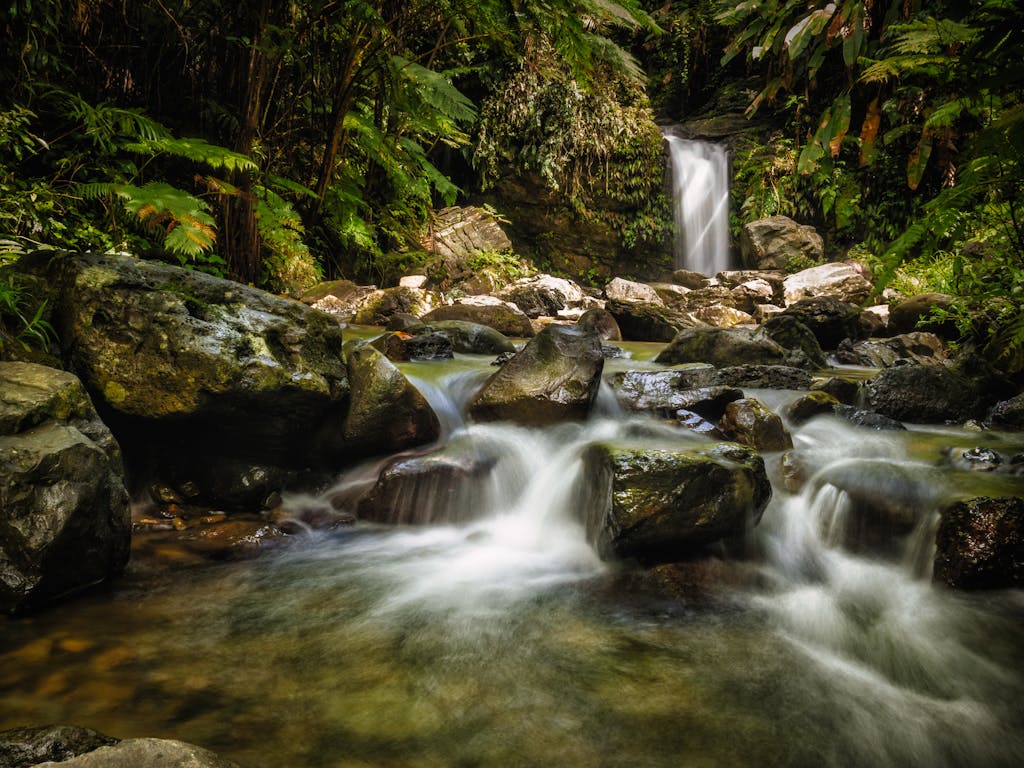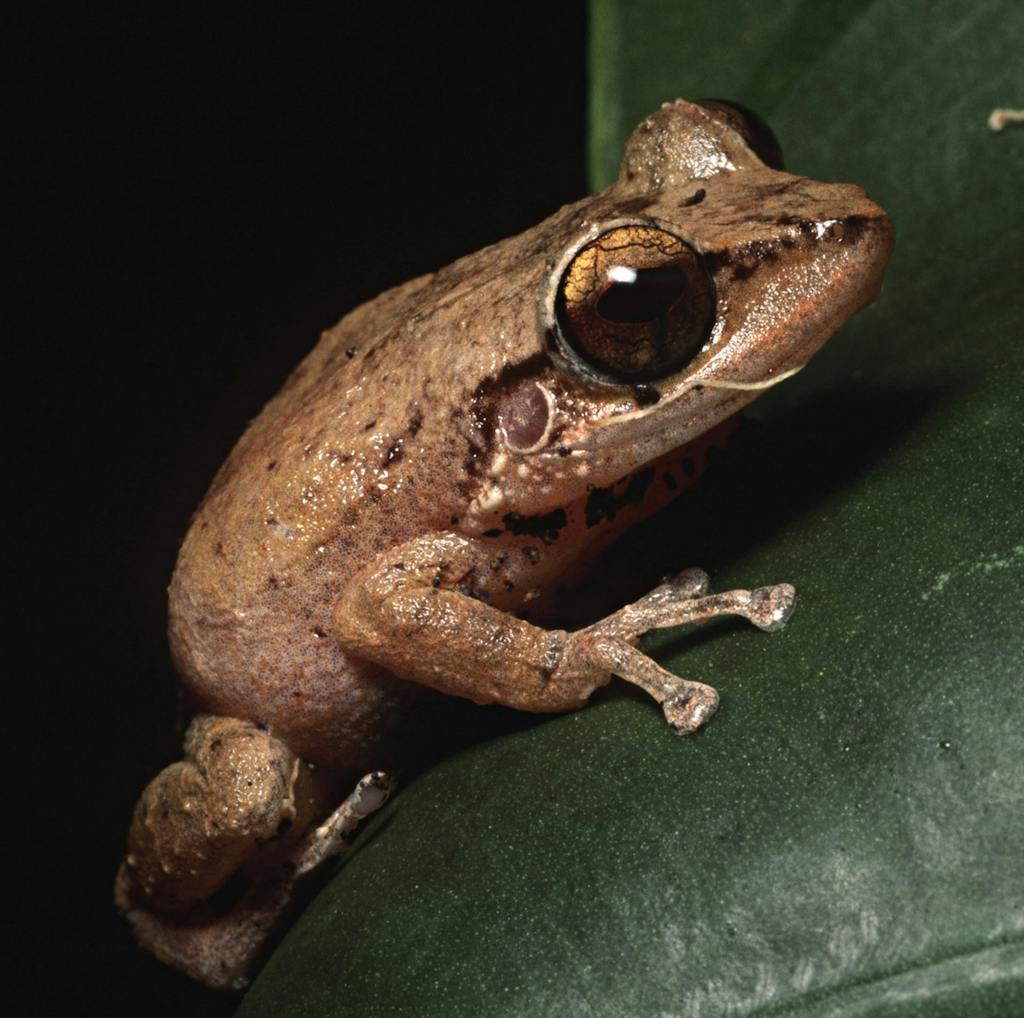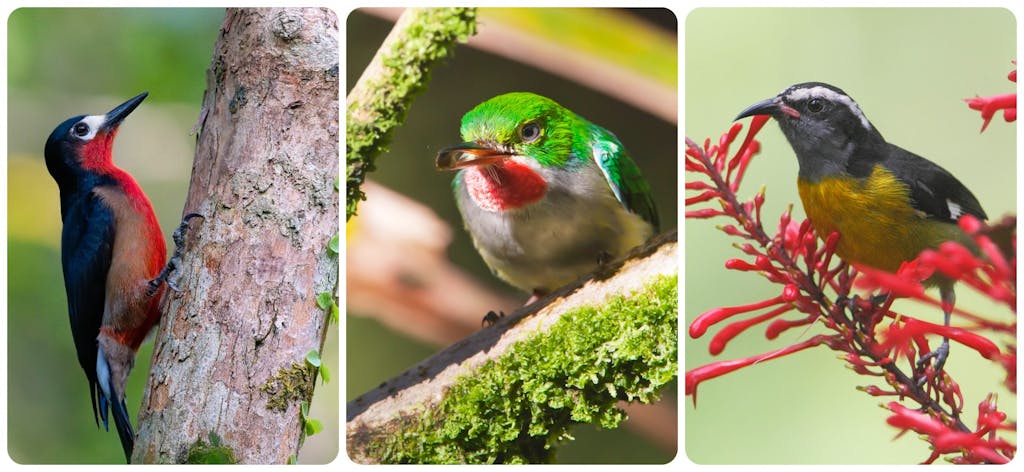In Puerto Rico, a Rarity: A U.S. Tropical Rain Forest Full of Falls, Fauna, Flowers
I hopped along large stepping-stones, avoiding the ankle-deep water gently lapping against the rocks at Juan Diego Falls. My family had made it to the first of many waterfalls, a short hike from the forest’s main entrance in Puerto Rico’s El Yunque National Forest.

My husband, son and I hiked up stairsteps of moss-covered rocks before the forest’s abundant ferns and palm trees opened up to reveal the cascading water. We headed toward the falls’ shallow pool, and I stood back, listening to the coos of what I thought were tropical birds. I later learned I wasn’t hearing birds, but the high-pitched meeps of coquí frogs, native to El Yunque.
Here, I realized El Yunque was more than a place to relax near a natural pool. It was a privilege to bear witness to one of the most biodiverse places on Earth – and the only tropical rainforest in the U.S. National Forest System.
A biological wonder that’s a constant balancing act

We wanted to beat the day-trippers, so we arose early on a Saturday morning to make the 40-minute drive from San Juan, the capital. We reached out first stop about 9 a.m., and although I was confident we’d beaten the biggest crowds, we weren’t alone. Several groups joined us along the rocks lining the waterfall’s thigh-deep pool to dip their toes in the cool water.
More than a million people visit El Yunque annually, which requires a balance in this biologically and culturally important ecosystem: Stewards are working on giving visitors better access to El Yunque while preserving the flora and fauna found nowhere else.
Puerto Ricans grew up enjoying the splendor of El Yunque, but visitors like us were only beginning to understand it. On this Saturday morning, we were feeling the pulse of the forest, a living breathing creature and a national treasure.
Preserving nature’s miracle

The name “El Yunque” derives from the Taino word for the mountains: “Yuké” means white land, referring to the cloud-covered peaks of the rainforest’s Luquillo Mountains. The U.S. Forest Service manages the land, about 28,000 acres, about 44 square miles, or the size of Rhode Island. El Yunque is on the eastern side of the island and is home to the coquí frog and other animal and plant species endemic to Puerto Rico.
As visitation grows, so does concern about managing the land responsibly. The Forest Service recently agreed to work with Cornell University’s Center for Sustainable Global Enterprise to create more renewable tourism in El Yunque as well as the communities around it.
“We have plans to expand opportunities in the El Yunque region, but we are mindful of avoiding unintended consequences that could worsen the current overtourism,” Keenan Adams, the Forest Supervisor, said in a statement announcing the partnership.

Plans are focused on developing new tourism offerings along Puerto Rico Highway 186, which runs in and out of the forest along El Yunque’s western border.
The major challenge is to ensure any new routes have the infrastructure to support extra visitors, said Megan Epler Wood, Managing Director of Cornell’s Sustainable Tourism Asset Management Program (STAMP). That includes more robust electricity allocation, wastewater management and solid waste disposal, repercussions of an increase in visitors.
“There’s often a lot of expenses left to local municipalities when more tourism comes, and they don’t have the source of revenue from tourism to build out their infrastructure,” Epler Wood said in an interview with Silversea.
Even with the challenges, she thinks the planning departments in towns surrounding El Yunque are well-positioned to innovate sustainable tourism in the area.
Tips for visiting

Visitors planning a trip to El Yunque today should best support local communities by hiring local guides, drivers, and other Puerto Rican businesses to help coordinate their travels. Tour guides coordinate trips to El Yunque from many of the big hotels in San Juan, or travelers can book their own with the listings on the website for Discover Puerto Rico.
“There are some really great places in that area, including some smaller bed and breakfasts that people can check out,” says O’Shannon Burns, Program M Director of Cornell’s STAMP. “If you’re going to spend a few days on island before or after a cruise, take advantage of the forest and see if you can do an overnight out there.”
One of her favorite excursions is a nighttime interpretive hike by tour company Para La Naturaleza, on which hikers can indulge in the sounds of the nocturnal forest.
Epler Wood recommends visitors take a moment to visit El Portal, El Yunque’s visitor’s center which often gets overlooked. The center reopened in 2022 after damage in September 2017 from back-to-back hurricanes Irma and Maria.
Visitor center tickets cost $8 a person for those 16 and older. El Portal has wheelchair-accessible trails and cultural touchpoints, such as rotating exhibits from local artists.

Jorge A. Montalvo Soto, whose company, Patria Tours, has been leading guided tours to El Yunque for eight years, recommends planning your visit to El Yunque so you can focus on the forest when you arrive.
“Feel how the forest gives us life,” Soto says. “The forest is our treasure. It’s a site of cultural heritage. It’s a site of unique biodiversity. And it’s a place that gives life.”
Once my family left the waterfall, we hopped back in the car and made a quick stop at Yokahú Tower, a 69-foot-tall concrete column near a ledge looking over El Yunque. (The name Yokahú comes from the name of the Taino god of fertility.)
I could see miles of El Yunque from here, and it made me appreciate the lushness of this fertile forest. Millions of trees stretched across the forest floor, creating a thick canopy in every direction. I felt energized being among these protected trees and waterways, and I hope the next generations of visitors will be able to admire El Yunque as we did.
